Wikipedia:Picture of the day/October 2014
|
Featured picture tools: |
These featured pictures, as scheduled below, appeared as the picture of the day (POTD) on the English Wikipedia's Main Page in October 2014. Individual sections for each day on this page can be linked to with the day number as the anchor name (e.g. [[Wikipedia:Picture of the day/October 2014#1]] for October 1).
You can add an automatically updating POTD template to your user page using {{Pic of the day}} (version with blurb) or {{POTD}} (version without blurb). For instructions on how to make custom POTD layouts, see Wikipedia:Picture of the day.
October 1

|
An aerial view of Ma'aleh Akrabim (Scorpions Pass), part of Israel's Route 227. This steep, twisted road is considered dangerous owing to its poor physical condition. Below the pass there is a dropoff of hundreds of metres, yet the road has no guard rails. Photo: אילן ארד
Recently featured:
|
October 2
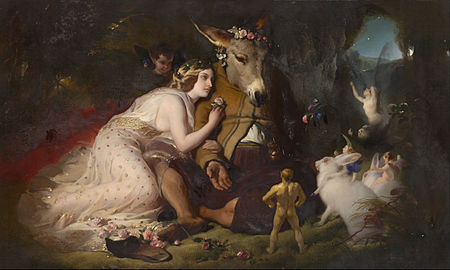
|
|
A Midsummer Night's Dream is a comedy play by William Shakespeare, probably written between 1590 and 1596, about events surrounding the marriage of Theseus, the Duke of Athens, to Hippolyta, the Queen of the Amazons. This scene shows two victims of mischievous fairies: the fairy queen Titania and the human weaver Bottom. She is smitten with him due to Oberon's love potion, while his head was changed to an ass's by Puck. This Edwin Landseer painting, Scene from A Midsummer Night's Dream, was commissioned by the engineer Isambard Kingdom Brunel to hang on his dining room wall as part of a series of Shakespeare-themed works. The painting, its subject likely selected by Landseer for its close ties to animals, was popular from its first exhibition; the future Queen Victoria described it as "a gem, beautifully fairy-like and graceful". Painting: Edwin Landseer
Recently featured:
|
October 3

|
Mehmed VI (1861–1926) was the 36th and last Sultan of the Ottoman Empire. He was girded with the Sword of Osman in June 1918, with his reign beginning the following month after his brother's death. Following the Ottoman defeat in World War I, Mehmed VI was tasked with reconciliation with the Allies. However, his settlements were denounced by Turkish nationalists, and in 1922 the Grand National Assembly of Turkey abolished the sultanate. Mehmed VI spent the rest of his life in exile. Photo: Sébah & Joaillier; restoration: Adam Cuerden
Recently featured:
|
October 4

|
Mount Merapi is a stratovolcano located about 28 kilometres (17 miles) north of Yogyakarta, Indonesia. It has erupted regularly since the 16th century. This Decade Volcano's eruptions in 2010 killed more than 350 people, leading to an exclusion zone of 2.5 kilometres (1.6 mi) from the peak. Photo: Chris Woodrich
Recently featured:
|
October 5

|
The marsh frog (Pelophylax ridibundus) is a species of true frog and the largest frog native to Europe; females of this sexually dimorphic species may be up to 17 centimetres (6.7 in) long. The marsh frog feeds mainly on insects, but it also eats smaller amphibians, fish, and rodents. Photo: Marie-Lan Nguyen
Recently featured:
|
October 6

|
Mammy's Cupboard is a roadside restaurant located on US Highway 61 south of Natchez, Mississippi. The restaurant was built in the shape of a mammy archetype at a time when Gone with the Wind had made it popular; the archetype's skin was repainted a lighter shade during the Civil Rights Movement of the 1960s. Diners sit in the restaurant's brick skirt, which also holds a gift shop. This photograph is from the Carol M. Highsmith archive at the Library of Congress, a collection of photographs of Americana donated to the library by the photographer and released into the public domain. Photo: Carol M. Highsmith
Recently featured:
|
October 7

|
Karen L. Nyberg (b. 1969) is an American mechanical engineer and NASA astronaut. This Minnesota native began working at the Johnson Space Center while still a University of North Dakota student in the 1990s. In 2000, she was selected to train for NASA's space program. She made her first flight in 2008, as part of STS-124, and has logged 180 days in space as of 2014. Photo: NASA
Recently featured:
|
October 8

|
The bush cockroach (Ellipsidion australe) is a cockroach of the order Blattodea, of which about 30 species out of 4,600 total are associated with human habitats. Living in a wide range of environments around the world, cockroaches are among the hardiest insects, capable of remaining active for a month without food and able to survive on limited resources. Photograph: Cyron Ray Macey
Recently featured:
|
October 9

|
The white-necked petrel (Pterodroma cervicalis) is a seabird in the family Procellariidae; adults measure some 43 centimetres (17 in) in length, with a wingspan of 95–105 centimetres (37–41 in). Although the species is found in much of the South Pacific, it breeds on only three islands and is thus considered vulnerable by the IUCN. Photograph: JJ Harrison
Recently featured:
|
October 10
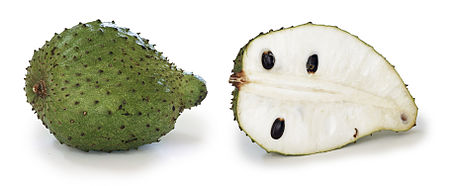
|
|
The soursop is the fruit of Annona muricata, an evergreen from Central and South America adapted to areas of high humidity and relatively warm winters. The taste has been described as a combination of strawberry and pineapple, with sour citrus flavour notes contrasting with an underlying creamy flavour reminiscent of coconut or banana. Photograph: Muhammad Mahdi Karim
Recently featured:
|
October 11

|
A family portrait of an Inupiat mother, father, and son, photographed in Noatak, Alaska, by Edward S. Curtis circa 1929. The Inupiat are an Alaska Native people whose traditional territory spans from the Norton Sound on the Bering Sea to the Canadian border. At the time this picture was taken, most were living in coastal areas, having migrated there during a period of starvation and an influenza epidemic. Photograph: Edward S. Curtis; restoration: Keraunoscopia
Recently featured:
|
October 12
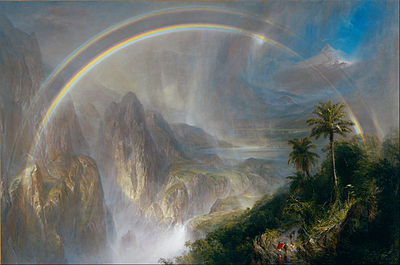
|
Rainy Season in the Tropics, an 1866 painting by the American landscape painter Frederic Edwin Church. A central figure in the Hudson River School, Church was inspired by romanticism and luminism in his depictions of dramatic natural phenomena. He traveled widely, including twice to South America (as here), but also around the Mediterranean and the Middle East. Rainy Season in the Tropics has often been associated with Church's Aurora Borealis, both as a completion of an arctic-tropical sequence which also includes The Heart of the Andes and The Icebergs, and because of similar luminosity and composition which suggest a "renewed optimism in natural and historic events". Painting: Frederic Edwin Church
Recently featured:
|
October 13

|
The New Town Hall is a city hall in Hanover, Germany. Completed over 12 years, it was opened in 1913. The observation deck in the center is almost 100 metres (330 ft) high and accessible via an elevator which follows a parabolic course. Photograph: Thomas Wolf
Recently featured:
|
October 14

|
|
An anatomical diagram of a hypothetical ancestral mollusc. Whether or not such a creature ever existed is a subject of debate among evolutionary biologists, but the construct or bauplan depicted here includes most of the physical attributes likely present in some form of shared molluscan ancestor, including a nervous system which is hypoathroid, an unsegmented, bilaterally symmetrical body, a single domed shell, and with organs occurring either singly or in pairs (i.e., with no metamerism). Biologists began drawing bauplans of molluscs in the late 19th century in an attempt to summarize the common features of the molluscan phylum. As pictures, however, these illustrations sometimes may actually serve to constrain theoretical understanding rather than aid it, especially given the absence of any specific fossil evidence of such a creature having existed. Nevertheless, depictions continue to be made and revised: organs become rearranged, emphases shift and settle, and the pictures themselves become a subject of analysis (or meta-analysis) quite apart from their completeness or accuracy as scientific works. Diagram: K.D. Schroeder
Recently featured:
|
October 15

|
A map of the world using the Natural Earth projection, a pseudocylindrical projection which is neither conformal nor equal-area. The projection was designed by Tom Patterson, an American cartographer with the National Park Service who has developed several open-source tools and base maps for cartographers. This map is a derivative of NASA's Blue Marble summer month composite, with oceans lightened to enhance legibility and contrast. Map: Strebe, using the Geocart map projection software
Recently featured:
|
October 16

|
A crashed Hannover CL.III, shot down by American machine gunners in the First World War. The successor to the CL.II, the CL.III was a two-seat multi-role aircraft, primarily used as a ground-attack machine, that first flew in 1917. Photograph: J. E. Gibbon; restoration: Keraunoscopia
Recently featured:
|
October 17

|
The grey-headed albatross (Thalassarche chrysostoma) is an albatross, averaging 81 cm (32 in) in length and 2.2 m (7.2 ft) in wingspan, which breeds further south than any other mollymawk. Though its common name derives from the species' ashy-grey head, throat and upper neck, the scientific name is a reference to the bright golden streaks on its bill. Photograph: JJ Harrison
Recently featured:
|
October 18

|
A field of common sunflowers (Helianthus annuus) near Cardejón, Aragon, Spain. This species of sunflower, indigenous to the Americas, was brought to Europe in the 16th century and used widely (together with its oil) as a cooking ingredient, though it can also be used as bird food, as livestock forage, and in some industrial applications. Photograph: Diego Delso
Recently featured:
|
October 19

|
A lithograph depicting the Battle of Fort Sanders, the decisive engagement of the 1863 Knoxville Campaign during the American Civil War. The Confederate army, under Lt. Gen. James Longstreet, attacked the Union salient of Fort Sanders. Although he had superior numbers, Longstreet planned poorly and was unable to break through the fort's defenses; he called off his attack after 20 minutes. The Union defenders, under Maj. Gen. Ambrose Burnside, suffered 13 casualties to the Confederates' 813. Lithograph: Kurz and Allison; restoration: Adam Cuerden
Recently featured:
|
October 20

|
A female Zygoballus rufipes, a species of jumping spider found from Central America through Canada. First described in 1885 by George and Elizabeth Peckham, there were initially thought to be two species (Z. bettini to the north and Z. rufipes to the south), but they have since been synonymized. Photograph: Ryan Kaldari
Recently featured:
|
October 21
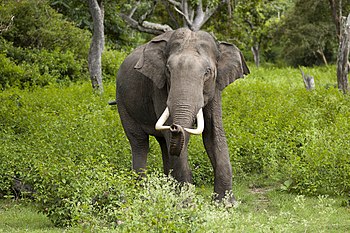
|
A male Indian elephant (Elephas maximus indicus) in Bandipur National Park, Karnataka. First described by Georges Cuvier in 1798, this subspecies of Asian elephant is considered endangered owing to large population declines since the mid-20th century. Photograph: Yathin S Krishnappa
Recently featured:
|
October 22

|
Fantine, a character in Victor Hugo's novel Les Misérables, in an 1886 painting by Margaret Bernadine Hall. In the novel, Fantine is a young orphan girl who is impregnated by a rich student, who then abandons her and their child Cosette. Forced by her poverty to become a prostitute, Fantine sacrifices her youth, beauty, and health in order to raise her daughter. After she dies, Cosette is raised by Jean Valjean. Fantine has been described as the "quintessential mother" whose sacrifice serves the good of her child, and identified with "the saved and saintly prostitute". She has been depicted in numerous adaptations of the novel, including the musical and the 2012 film (in which she was portrayed by Anne Hathaway). Painting: Margaret Bernadine Hall
Recently featured:
|
October 23

|
"Weird Al" Yankovic (b. 1959) is an American musician known for his humorous songs which make light of popular culture and often parody specific songs by contemporary musical acts. His parodies often extend to his music videos, which may at times be scene-for-scene reinterpretations of the originals. He has won three Grammy Awards, sold more than 12 million albums between 1976 and 2007, and recorded over 150 songs. Photograph: Kyle Cassidy
Recently featured:
|
October 24

|
The northern carmine bee-eater (Merops nubicus) is a near passerine bird in the bee-eater family. Native to Africa, the species is predominantly carmine in colour. Its diet consists mostly of bees and other flying insects. Photograph: Luc Viatour
Recently featured:
|
October 25
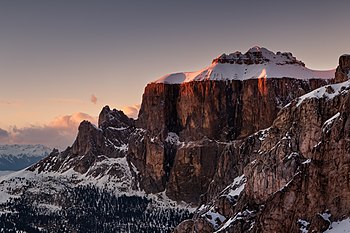
|
An evening view of the Sella group, a plateau-shaped massif in the Dolomites mountains of northern Italy. The highest peak is Piz Boè at 3,151 m (10,338 ft) above sea level. Visible here are Piz Ciavazes on the right and Torri del Sella on the left. Photograph: Dmitry A. Mottl
Recently featured:
|
October 26

|
The installation of high-density polyethylene (HDPE) pipe in a storm drain project in Mexico, photographed in 2012. HDPE is a polyethylene thermoplastic made from petroleum that is known for its high strength to density ratio. It is commonly used in the production of plastic bottles, corrosion-resistant piping, and plastic lumber. Photograph: Tomas Castelazo
Recently featured:
|
October 27

|
Yacht racing is a sport in which yachts and larger sailboats are raced. Modern yacht racing emerged in the 18th century, and attempts to standardize rules began in the 1800s. Depicted here is the start of the 2013 Cabo San Lucas Race, in which the yachts are raced from Newport Beach, California, to Cabo San Lucas, Mexico. Photograph: D Ramey Logan
Recently featured:
|
October 28

|
The CN Tower is a 553.33 m high (1,815.4 ft) concrete communications and observation tower in downtown Toronto, Ontario. Upon completion in 1976, it was the world's tallest free-standing structure and tallest tower. It held both records for 34 years until the completion of Burj Khalifa and Canton Tower, respectively, both in 2010. It remains the tallest free-standing structure in the Western Hemisphere. Photograph: Taxiarchos228
Recently featured:
|
October 29

|
The armies of the Mughal Emperor Humayun fighting those of Bahadur Shah of Gujarat in the year 1535, as depicted in an Akbarnama manuscript from the late 16th century. Bahadur, the Sultan of Gujarat, had allied with the Portuguese and planned an attack on the Mughals. To preempt such an attack, Humayun struck at Gujarat and conquered Mandu and Champaner before stopping his attack. Bahadur Shah was killed by the Portuguese two years later; Humayun was overthrown by Sher Shah Suri in 1540, retaking the throne fifteen years later. Illustration: Dharmdas, Manre Royale d’Aubusson
Recently featured:
|
October 30

|
Grammodes geometrica is a species of moth in the genus Grammodes. It is found from the Mediterranean east through the Asian and Australasian tropics. Photograph: Muhammad Mahdi Karim
Recently featured:
|
October 31

|
Edward Scriven's engraving of John Masey Wright's illustration to Robert Burns' poem "Halloween". First published in 1786, the poem is included in the Kilmarnock volume and is one of Burns' longer poems. Illustration: John Masey Wright and Edward Scriven; restoration: Adam Cuerden
Recently featured:
|
Picture of the day archives and future dates
